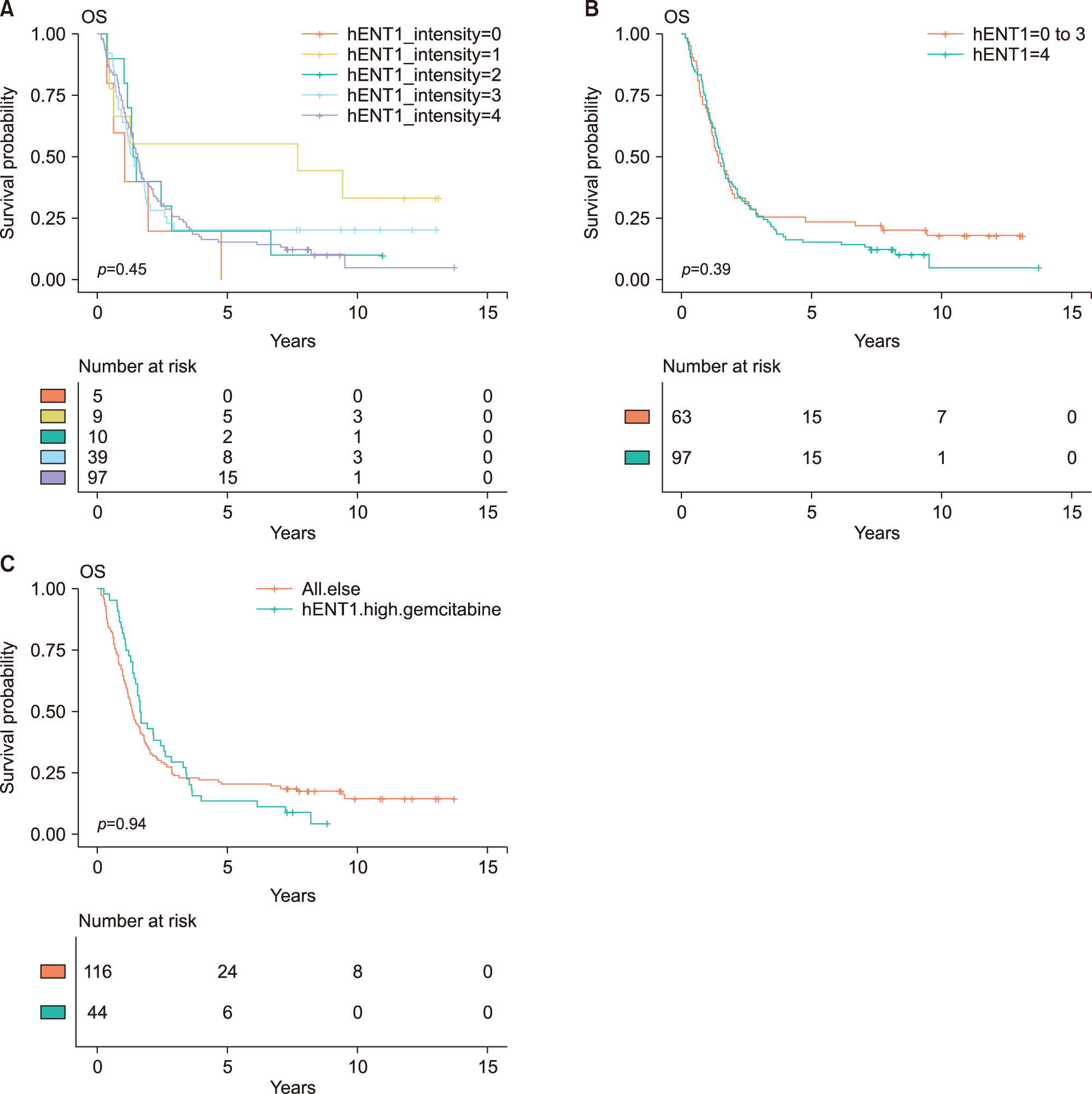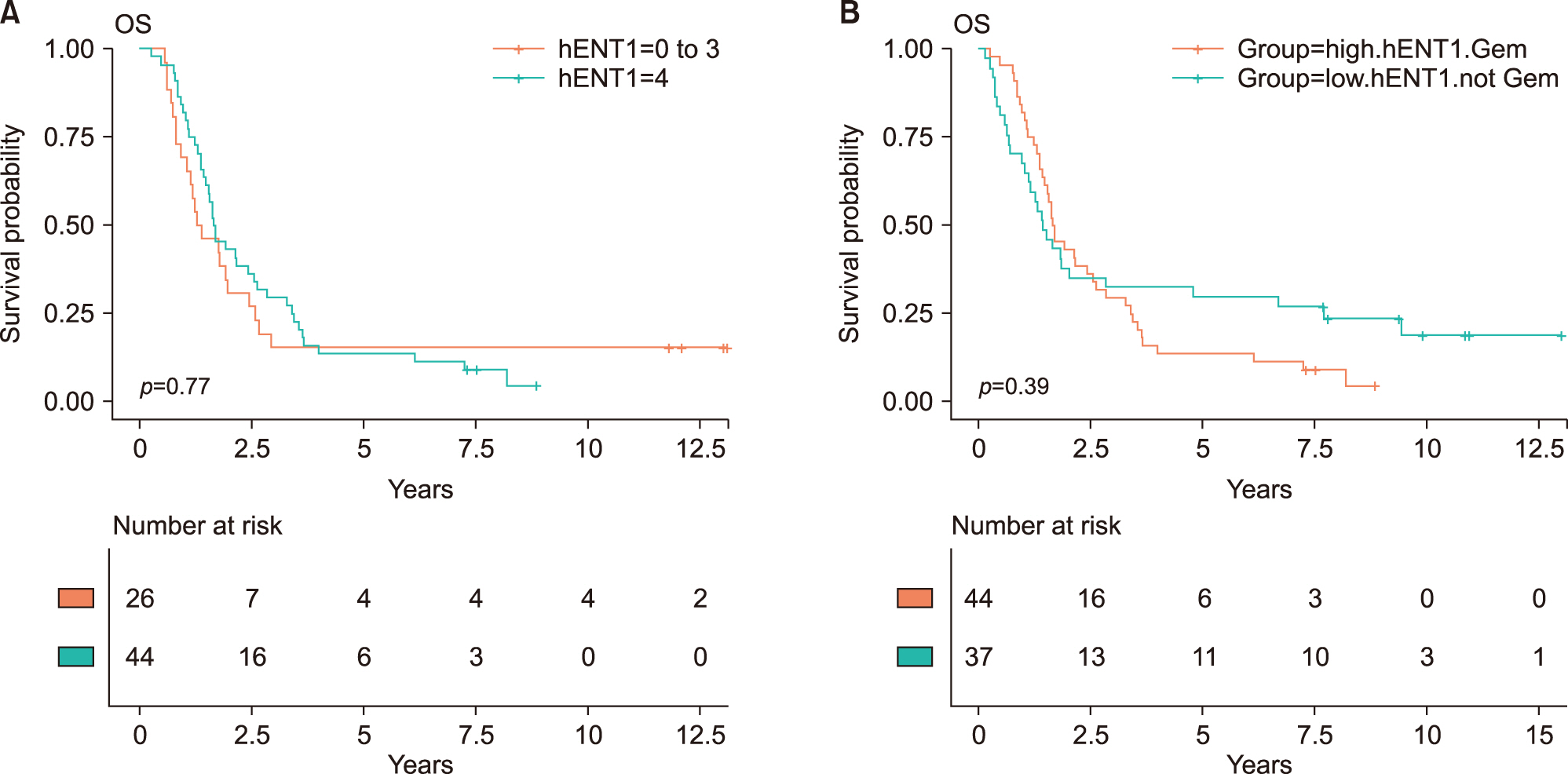Ann Hepatobiliary Pancreat Surg.
2020 May;24(2):127-136. 10.14701/ahbps.2020.24.2.127.
Human equilibrative nucleoside transporter-1 (hENT1) and ribonucleotide reductase regulatory subunit M1 (RRM1) expression; do they have survival impact to pancreatic cancer?
- Affiliations
-
- 1Division of Hepatobiliary and Pancreatic Surgery, Department of Surgery, Asan Medical Center, University of Ulsan College of Medicine, Seoul, Korea
- 2Department of Pathology, Hallym University Dongtan Sacred Heart Hospital, Hwaseong, Korea
- 3Department of Surgery, Seoul National University College of Medicine, Seoul National University Bundang Hospital, Seongnam, Korea
- KMID: 2500772
- DOI: http://doi.org/10.14701/ahbps.2020.24.2.127
Abstract
- Backgrounds/Aims
Gemcitabine is still one of adjuvant options in chemotherapeutic agent for pancreatic ductal adenocarcinoma (PDAC). Integral membrane transporter protein and intracellular enzymes including human equilibrative nucleoside transporter 1 (hENT1), deoxycytidine kinase (dCK), ribonucleotide reductase (RR) M1, and M2 are known as important factors for chemosensitivity of gemcitabine. We aimed to investigate the correlation between these key molecules and 5-year actual survival in PDAC patients.
Methods
The expression of intratumoral hENT1, dCK, RRM1, and RRM2 was assessed immunohistochemically in 160 PDAC patients underwent surgical resection. Association between clininopathologic factors, immunohistochemical results, and overall survival were analyzed.
Results
Adjuvant chemotherapy including concurrent chemoradiotherapy was not associated with overall survival (HR, 0.92; 95% CI, 0.65-1.31; p=0.658). High hENT1 expression group did not show statistical survival difference, compared with all others (HR, 1.16; 95% CI, 0.82-1.65, p=0.396). Gemcitabine therapy and high hENT1 group was compared with all other patients, and no difference in overall survival was identified (HR, 0.99; 95% CI, 0.68-1.42; p=0.940). And, gemcitabine therapy and high hENT1 group did not differ statistically from gemcitabine therapy and low hENT1 expression (HR, 0.92; 95% CI, 0.55-1.56; p=0.764). The intensity of dCK, RRM1, and RRM2 expression was not associated with overall survival (p=0.413, p=0.138 and p=0.061) in univariate analysis.
Conclusions
The expression of hENT1, dCK, RRM1 and RRM2 may not be associated with overall survival for patients with pancreatic cancer on gemcitabine adjuvant therapy. These proteins and other factors that may interact with or confound these results should be investigated in the near future.
Keyword
Figure
Reference
-
1. Neoptolemos JP, Stocken DD, Bassi C, Ghaneh P, Cunningham D, Goldstein D, et al. 2010; Adjuvant chemotherapy with fluorouracil plus folinic acid vs gemcitabine following pancreatic cancer resection: a randomized controlled trial. JAMA. 304:1073–1081. DOI: 10.1001/jama.2010.1275. PMID: 20823433.2. Ritzel MW, Ng AM, Yao SY, Graham K, Loewen SK, Smith KM, et al. 2001; Recent molecular advances in studies of the concentrative Na+-dependent nucleoside transporter (CNT) family: identification and characterization of novel human and mouse proteins (hCNT3 and mCNT3) broadly selective for purine and pyrimidine nucleosides (system cib). Mol Membr Biol. 18:65–72. DOI: 10.1080/09687680010026313. PMID: 11396613.
Article3. Mori R, Ishikawa T, Ichikawa Y, Taniguchi K, Matsuyama R, Ueda M, et al. 2007; Human equilibrative nucleoside transporter 1 is associated with the chemosensitivity of gemcitabine in human pancreatic adenocarcinoma and biliary tract carcinoma cells. Oncol Rep. 17:1201–1205. DOI: 10.3892/or.17.5.1201. PMID: 17390066.
Article4. García-Manteiga J, Molina-Arcas M, Casado FJ, Mazo A, Pastor-Anglada M. 2003; Nucleoside transporter profiles in human pancreatic cancer cells: role of hCNT1 in 2',2'-difluorodeoxycytidine- induced cytotoxicity. Clin Cancer Res. 9:5000–5008. PMID: 14581375.5. Mackey JR, Mani RS, Selner M, Mowles D, Young JD, Belt JA, et al. 1998; Functional nucleoside transporters are required for gemcitabine influx and manifestation of toxicity in cancer cell lines. Cancer Res. 58:4349–4357. PMID: 9766663.6. Maréchal R, Bachet JB, Mackey JR, Dalban C, Demetter P, Graham K, et al. 2012; Levels of gemcitabine transport and metabolism proteins predict survival times of patients treated with gemcitabine for pancreatic adenocarcinoma. Gastroenterology. 143:664–674.e6. DOI: 10.1053/j.gastro.2012.06.006. PMID: 22705007.
Article7. Ruiz van Haperen VW, Veerman G, Vermorken JB, Peters GJ. 1993; 2',2'-Difluoro-deoxycytidine (gemcitabine) incorporation into RNA and DNA of tumour cell lines. Biochem Pharmacol. 46:762–766. DOI: 10.1016/0006-2952(93)90566-F. PMID: 8363650.
Article8. Sebastiani V, Ricci F, Rubio-Viqueira B, Kulesza P, Yeo CJ, Hidalgo M, et al. 2006; Immunohistochemical and genetic evaluation of deoxycytidine kinase in pancreatic cancer: relationship to molecular mechanisms of gemcitabine resistance and survival. Clin Cancer Res. 12:2492–2497. DOI: 10.1158/1078-0432.CCR-05-2655. PMID: 16638857. PMCID: PMC3619210.
Article9. Bepler G, Kusmartseva I, Sharma S, Gautam A, Cantor A, Sharma A, et al. 2006; RRM1 modulated in vitro and in vivo efficacy of gemcitabine and platinum in non-small-cell lung cancer. J Clin Oncol. 24:4731–4737. DOI: 10.1200/JCO.2006.06.1101. PMID: 16966686.
Article10. Nakahira S, Nakamori S, Tsujie M, Takahashi Y, Okami J, Yoshioka S, et al. 2007; Involvement of ribonucleotide reductase M1 subunit overexpression in gemcitabine resistance of human pancreatic cancer. Int J Cancer. 120:1355–1363. DOI: 10.1002/ijc.22390. PMID: 17131328.
Article11. Lee HS, Kim WH. 2006; Tissue array methods for high-throughput clinicopathologic research. Cancer Res Treat. 38:1–6. DOI: 10.4143/crt.2006.38.1.1. PMID: 19771251. PMCID: PMC2741654.
Article12. Farrell JJ, Elsaleh H, Garcia M, Lai R, Ammar A, Regine WF, et al. 2009; Human equilibrative nucleoside transporter 1 levels predict response to gemcitabine in patients with pancreatic cancer. Gastroenterology. 136:187–195. DOI: 10.1053/j.gastro.2008.09.067. PMID: 18992248.
Article13. Maréchal R, Mackey JR, Lai R, Demetter P, Peeters M, Polus M, et al. 2010; Deoxycitidine kinase is associated with prolonged survival after adjuvant gemcitabine for resected pancreatic adenocarcinoma. Cancer. 116:5200–5206. DOI: 10.1002/cncr.25303. PMID: 20669326.
Article14. Nakagawa N, Murakami Y, Uemura K, Sudo T, Hashimoto Y, Kondo N, et al. 2013; Combined analysis of intratumoral human equilibrative nucleoside transporter 1 (hENT1) and ribonucleotide reductase regulatory subunit M1 (RRM1) expression is a powerful predictor of survival in patients with pancreatic carcinoma treated with adjuvant gemcitabine-based chemotherapy after operative resection. Surgery. 153:565–575. DOI: 10.1016/j.surg.2012.10.010. PMID: 23253379.15. Conroy T, Hammel P, Hebbar M, Ben Abdelghani M, Wei AC, Raoul JL, et al. 2018; FOLFIRINOX or gemcitabine as adjuvant therapy for pancreatic cancer. N Engl J Med. 379:2395–2406. DOI: 10.1056/NEJMoa1809775. PMID: 30575490.
Article16. Morinaga S, Nakamura Y, Watanabe T, Mikayama H, Tamagawa H, Yamamoto N, et al. 2012; Immunohistochemical analysis of human equilibrative nucleoside transporter-1 (hENT1) predicts survival in resected pancreatic cancer patients treated with adjuvant gemcitabine monotherapy. Ann Surg Oncol. 19(Suppl 3):S558–S564. DOI: 10.1245/s10434-011-2054-z. PMID: 21913012.
Article17. Sierzega M, Pach R, Kulig P, Legutko J, Kulig J. 2017; Prognostic implications of expression profiling for gemcitabine-related genes (hENT1, dCK, RRM1, RRM2) in patients with resectable pancreatic adenocarcinoma receiving adjuvant chemotherapy. Pancreas. 46:684–689. DOI: 10.1097/MPA.0000000000000807. PMID: 28196013.
Article18. Farrell JJ, Moughan J, Wong JL, Regine WF, Schaefer P, Benson AB 3rd, et al. 2016; Precision medicine and pancreatic cancer: a gemcitabine pathway approach. Pancreas. 45:1485–1493. DOI: 10.1097/MPA.0000000000000710. PMID: 27748721. PMCID: PMC5119656.19. Elander NO, Aughton K, Ghaneh P, Neoptolemos JP, Palmer DH, Cox TF, et al. 2018; Expression of dihydropyrimidine dehydrogenase (DPD) and hENT1 predicts survival in pancreatic cancer. Br J Cancer. 118:947–954. DOI: 10.1038/s41416-018-0004-2. PMID: 29515256. PMCID: PMC5931115.
Article
- Full Text Links
- Actions
-
Cited
- CITED
-
- Close
- Share
- Similar articles
-
- p21-Activated Kinase 4 (PAK4) as a Predictive Marker of Gemcitabine Sensitivity in Pancreatic Cancer Cell Lines
- Promoter Polymorphism of RRM1 Gene in Korean Lung Cancer Population
- Extraordinary Response of Metastatic Pancreatic Cancer to Chemotherapy
- High Expression of Ribonucleotide Reductase Subunit M2 Correlates with Poor Prognosis of Hepatocellular Carcinoma
- CD40 Agonists Alter the Pancreatic Cancer Microenvironment by Shifting the Macrophage Phenotype toward M1 and Suppress Human Pancreatic Cancer in Organotypic Slice Cultures



